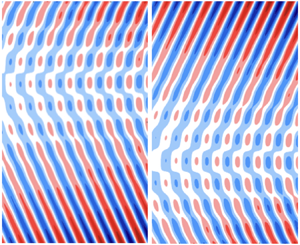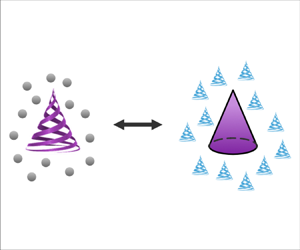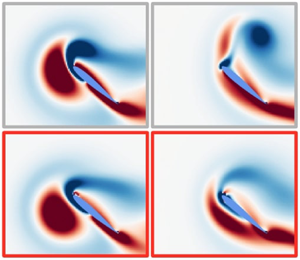doi:10.1017/jfm.2024.548 Bragg & de Bruyn Kops Understanding the effect of Prandtl number on momentum and scalar mixing rates in neutral and stably stratified flows using gradient field dynamics
JFM Rapids
One-winged butterflies: mode selection for azimuthal magnetorotational instability by thermal convection
-
- Published online by Cambridge University Press:
- 27 August 2024, R1
-
- Article
-
- You have access
- Open access
- HTML
- Export citation
The effect of Reynolds number on the separated flow over a low-aspect-ratio wing
-
- Published online by Cambridge University Press:
- 10 September 2024, R2
-
- Article
-
- You have access
- Open access
- HTML
- Export citation
Focus on Fluids
Mixture theory for diffuse interface models of two-phase flows
-
- Published online by Cambridge University Press:
- 13 September 2024, F1
-
- Article
-
- You have access
- Open access
- HTML
- Export citation
JFM Papers
Non-local gravity wave turbulence in presence of condensate
-
- Published online by Cambridge University Press:
- 27 August 2024, A1
-
- Article
-
- You have access
- Open access
- HTML
- Export citation
Thin-film flow due to an asymmetric distribution of surface tension and applications to surfactant deposition
-
- Published online by Cambridge University Press:
- 27 August 2024, A2
-
- Article
-
- You have access
- Open access
- HTML
- Export citation
Obstacle arrangement can control flows through porous obstructions
-
- Published online by Cambridge University Press:
- 28 August 2024, A3
-
- Article
-
- You have access
- Open access
- HTML
- Export citation
Turbulence effect on disk settling dynamics
-
- Published online by Cambridge University Press:
- 27 August 2024, A4
-
- Article
-
- You have access
- Open access
- HTML
- Export citation
Trading particle shape with fluid symmetry: on the mobility matrix in 3-D chiral fluids
-
- Published online by Cambridge University Press:
- 27 August 2024, A5
-
- Article
-
- You have access
- Open access
- HTML
- Export citation
Mixing as a correlated aggregation process
-
- Published online by Cambridge University Press:
- 27 August 2024, A6
-
- Article
-
- You have access
- Open access
- HTML
- Export citation
Vibration-induced wall–bubble interactions under zero-gravity conditions
-
- Published online by Cambridge University Press:
- 27 August 2024, A7
-
- Article
- Export citation
Simulation and scaling analysis of periodic surfaces with small-scale roughness in turbulent Ekman flow
-
- Published online by Cambridge University Press:
- 30 August 2024, A8
-
- Article
-
- You have access
- Open access
- HTML
- Export citation
Non-universality and dissipative anomaly in compressible magnetohydrodynamic turbulence
-
- Published online by Cambridge University Press:
- 27 August 2024, A9
-
- Article
- Export citation
Understanding the effect of Prandtl number on momentum and scalar mixing rates in neutral and stably stratified flows using gradient field dynamics
-
- Published online by Cambridge University Press:
- 27 August 2024, A10
-
- Article
-
- You have access
- Open access
- HTML
- Export citation
On the coupling instability of a gas jet impinging on a liquid film
-
- Published online by Cambridge University Press:
- 27 August 2024, A11
-
- Article
-
- You have access
- Open access
- HTML
- Export citation
Direct numerical simulation of 45° oblique flow past surface-mounted square cylinder
-
- Published online by Cambridge University Press:
- 27 August 2024, A12
-
- Article
- Export citation
Dewetting of a corner film wrapping a wall-mounted cylinder
-
- Published online by Cambridge University Press:
- 27 August 2024, A13
-
- Article
-
- You have access
- Open access
- HTML
- Export citation
Emergence of lobed wakes during the sedimentation of spheres in viscoelastic fluids
-
- Published online by Cambridge University Press:
- 27 August 2024, A14
-
- Article
-
- You have access
- Open access
- HTML
- Export citation
The starting vortices generated by bodies with sharp and straight edges in a viscous fluid
-
- Published online by Cambridge University Press:
- 28 August 2024, A15
-
- Article
- Export citation
Effect of radius ratio on the sheared annular centrifugal turbulent convection
-
- Published online by Cambridge University Press:
- 13 September 2024, A16
-
- Article
- Export citation
Data-driven transient lift attenuation for extreme vortex gust–airfoil interactions
-
- Published online by Cambridge University Press:
- 10 September 2024, A17
-
- Article
-
- You have access
- Open access
- HTML
- Export citation











































































